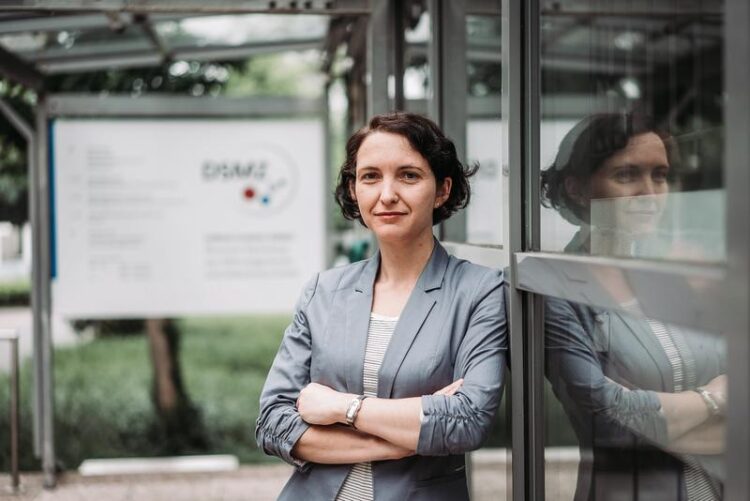German scientists report success in antibiotic research

Prof. Dr. Yvonne Mast, Leibniz-Institut DSMZ, Braunschweig
Credit: Michael Hübner / DSMZ
German Researcher at the Leibniz Institute DSMZ in Braunschweig develops new method for the derivatization of antibiotics.
Professor Dr Yvonne Mast, Head of the Department of Bioresources for Bioeconomy and Health Research, and her working group at the Leibniz Institute DSMZ-German Collection of Microorganisms and Cell Cultures have developed a new method for the derivatization of antibiotics. Antibiotics are medicinally important compounds often produced by microorganisms. Such natural substances often have a chemically complex structure and hence can be difficult or even impossible to chemically synthesize or modify by means of semi-synthesis.

Schematic representation of the biotransformation-coupled mutasynthesis approach. Amino acid precursor (white hexagons), mutasynthon (blue hexagons), pristinamycin I products (gray hexagons). (c) DSMZ/Mast
However, adapting these substances is often necessary to improve efficacy or, as in the case of antibiotics, to confer resistance-breaking properties. Mutasynthesis offers an alternative to the chemical modification or ‘derivatization’ of substances. This approach generates mutants of antibiotic-producing microorganisms, wherein the genes for the antibiotic precursor(s) are inactivated, so that the microorganism can no longer produce them. By “feeding” mutants with modified pre-products (the precursor derivates), these are then incorporated into the antibiotic precursor molecule, thus resulting in the production of new antibiotic derivatives.
Mutasynthesis: an approach to modify antibiotics
In a study recently published in an internationally renowned journal, Prof Mast’s working group describes a new mutasynthesis approach to derivatization of the antibiotic pristinamycin I. Pristinamycin is a streptogramin antibiotic used as an emergency drug against resistant pathogens. “We modified pristinamycin I based on the amino acid precursor phenylglycine by mutasynthesis”, explains antibiotics researcher Yvonne Mast.
“This was only possible because we had previously identified and functionally characterized the phenylglycine biosynthesis genes, allowing us to generate two new halogenated bioactive pristinamycin I derivatives in our current study. The novelty of this study lies in the fact that we coupled a biotransformation process to mutasynthesis, in which the phenylglycine derivative precursor is provided by a genetically modified bacterial strain (E. coli strain). So far, this is the only biotechnological process of its kind, which we have named ‘mutasynthesis 2.0’”, summarizes Prof Mast.
Press contact:
PhDr. Sven-David Müller, Head of Public Relations, Leibniz Institute DSMZ-German Collection of Microorganisms and Cell Cultures GmbH
Phone: ++49 (0)531/2616-300
Mail: press@dsmz.de
About the Leibniz Institute DSMZ
The Leibniz Institute DSMZ-German Collection of Microorganisms and Cell Cultures is the world’s most diverse collection of biological resources (bacteria, archaea, protists, yeasts, fungi, bacteriophages, plant viruses, genomic bacterial DNA as well as human and animal cell lines). Microorganisms and cell cultures are collected, investigated and archived at the DSMZ. As an institution of the Leibniz Association, the DSMZ with its extensive scientific services and biological resources has been a global partner for research, science and industry since 1969. The DSMZ was the first registered collection in Europe (Regulation (EU) No. 511/2014) and is certified according to the quality standard ISO 9001:2015. As a patent depository, it offers the only possibility in Germany to deposit biological material in accordance with the requirements of the Budapest Treaty. In addition to scientific services, research is the second pillar of the DSMZ. The institute, located on the Science Campus Braunschweig-Süd, accommodates more than 85,000 cultures and biomaterials and has around 220 employees. www.dsmz.de
The Leibniz Association
The Leibniz Association connects 96 independent research institutions that range in focus from the natural, engineering and environmental sciences via economics, spatial and social sciences to the humanities. Leibniz Institutes address issues of social, economic and ecological relevance. They conduct basic and applied research, including in the interdisciplinary Leibniz Research Alliances, maintain scientific infrastructure, and provide research-based services. The Leibniz Association identifies focus areas for knowledge transfer, particularly with the Leibniz research museums. It advises and informs policymakers, science, industry and the general public. Leibniz institutions collaborate intensively with universities – including in the form of Leibniz ScienceCampi – as well as with industry and other partners at home and abroad. They are subject to a transparent, independent evaluation procedure. Because of their importance for the country as a whole, the Leibniz Association Institutes are funded jointly by Germany’s central and regional governments. The Leibniz Institutes employ around 20,500 people, including 11,500 researchers. The financial volume amounts to 2 billion euros. www.leibniz-gemeinschaft.de
Originalpublikation:
Hennrich O, Weinmann L, Kulik A, Harms K, Klahn P, Youn J-W, Surup F, Mast Y (2023) Biotransformation-coupled mutasynthesis for the generation of novel pristinamycin derivatives by engineering the phenylglycine residue. RSC Chem Biol. 4:1050-1063.
doi: 10.1039/d3cb00143a.
Media Contact
All latest news from the category: Life Sciences and Chemistry
Articles and reports from the Life Sciences and chemistry area deal with applied and basic research into modern biology, chemistry and human medicine.
Valuable information can be found on a range of life sciences fields including bacteriology, biochemistry, bionics, bioinformatics, biophysics, biotechnology, genetics, geobotany, human biology, marine biology, microbiology, molecular biology, cellular biology, zoology, bioinorganic chemistry, microchemistry and environmental chemistry.
Newest articles

Innovative 3D printed scaffolds offer new hope for bone healing
Researchers at the Institute for Bioengineering of Catalonia have developed novel 3D printed PLA-CaP scaffolds that promote blood vessel formation, ensuring better healing and regeneration of bone tissue. Bone is…

The surprising role of gut infection in Alzheimer’s disease
ASU- and Banner Alzheimer’s Institute-led study implicates link between a common virus and the disease, which travels from the gut to the brain and may be a target for antiviral…

Molecular gardening: New enzymes discovered for protein modification pruning
How deubiquitinases USP53 and USP54 cleave long polyubiquitin chains and how the former is linked to liver disease in children. Deubiquitinases (DUBs) are enzymes used by cells to trim protein…



